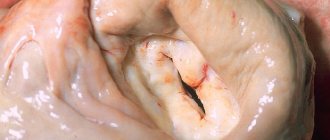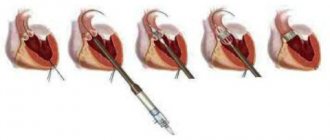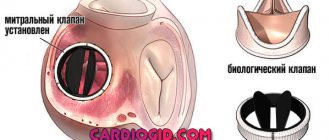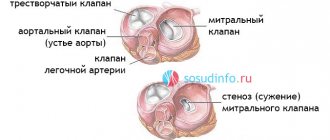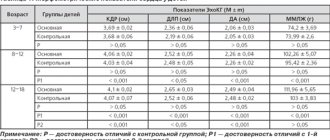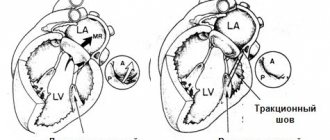Mitral valve prolapse of the 1st degree is the initial phase of congenital or acquired heart disease. The essence of the deviation is a violation of the elasticity of the anatomical structure.
The MV acts as a septum between the left atrium and the same ventricle. With the development of prolapse, a reverse outflow of blood (regurgitation) into the previous chamber is observed. Hence the drop in hemodynamics and the impossibility of normal functioning of the organ.
Treatment is strictly surgical. Prospects depend on the duration of the pathological process, the presence or absence of concomitant conditions. Prosthetics are usually indicated. Plastic surgery has a small list of indications.
The diagnosis is made by a cardiologist. At stage 1, dynamic observation may be prescribed. Surgery is resorted to in difficult cases and when the defect progresses.
What is MVP (mitral valve prolapse)?
Mitral valve prolapse (MVP) is a cardiac anomaly and one of the most common heart pathologies.
In the presence of this pathology, the mitral valve leaflets sag/bulge into the atrium cavity; this occurs at the moment of contraction of the left ventricle of the heart. As a result of this cardiac abnormality, regurgitation can occur, where some blood flows back into the left atrium. This pathology is benign (unlike heart defects, for example), but, unfortunately, it can also have serious unpleasant consequences. Severe regurgitation can cause disability. In some cases, mitral valve prolapse requires serious treatment (medical or even surgical), in others, doctors limit themselves to only monitoring the patient; the person must undergo regular examinations and monitor his lifestyle. Very often a person does not know that he has PMH and this anomaly is discovered during a medical examination on some other issue, since the symptoms of this disease are often non-specific: headache, fatigue, dizziness, cardiac pain.
Therefore, it is very important if you have health problems, even if it is mild fatigue or malaise, which is long-lasting, not to put off visiting a doctor.
Passing a medical examination
After clarifying the essence of the pathology and the differences in severity, it is necessary to undergo a medical examination, since you will not be able to diagnose this disease yourself. The examination is carried out repeatedly to eliminate the risk of misdiagnosis.
The VVC raises the most questions about grade 2 prolapse. Young people need to adjust their regime: they should refrain from stress and overwork, heavy physical activity, which is not possible in the army. Therefore, intense military exercises are detrimental to the health of sick conscripts.
When determining the fitness category, members of the military commission rely on the following criteria:
- clear manifestations of heart rhythm disturbances;
- improper conductivity;
- heart failure.
If there are no characteristic symptoms of heart failure (shortness of breath, lethargy, accelerated heart rate), they will be accepted into the army with category “B-4”. The young man will be assigned to communications, radio engineering and other similar troops.
If the listed symptoms appear after physical activity, even if they disappear after it, the conscript can count on release.
Mitral valve prolapse: causes
There are 2 types of mitral valve prolapse - primary and secondary, depending on the origin of the pathology.
The causes of primary mitral valve prolapse are genetic defects. This issue has not yet been fully studied, but there is evidence that MVP is a disease that is inherited. In addition, negative factors that have a negative effect on the fetus while still in the womb can affect the possibility of a person developing MVP. Such factors include viral diseases of the mother during pregnancy, gestosis, and poor environmental conditions.
Primary MVP is divided into:
- Mitral valve prolapse as an independent disease.
- Mitral valve prolapse as a manifestation of connective tissue development disorders (connective tissue dysplasia, Marfan syndrome, Ehlers-Danlos syndrome). In this case, the pathology, in addition to MVP, can be manifested by hypermobility of the joints, curvature of the spine, deformation of the chest; a person often experiences dislocations and subluxations of the joints, and other symptoms.
The causes of secondary MVP are other diseases, and it is against their background that secondary cardiac prolapse occurs:
- congenital heart defects;
- acquired heart defects;
- ICHD (coronary heart disease);
- myocarditis;
- rheumatic heart disease;
- cardiomyopathy.
Pathogenesis of MVP.
The mitral valve separates the cavities of the ventricle of the heart and its left atrium. When the mitral valve is normal, its leaflets are “deviated” downward at the moment the myocardium relaxes and the cavities of the heart are filled with blood, and vice versa – the leaflets are “raised” upward at the moment of atrial contraction, the left atrioventricular orifice is closed. With MVP, the valve does not work correctly: during the phase of atrial contraction, the valve leaflets “bend” into the cavity of the left atrium, but this should not be the case. Indeed, for this reason, the atrioventricular opening is completely or partially blocked and a reverse movement of blood occurs from the left ventricle to the left atrium (mitral regurgitation).
If a person has mitral valve prolapse, the ability of the heart muscle to contract may decrease, which in turn can lead to circulatory failure; The presence of arterial hypotension, borderline pulmonary hypertension, metabolic disorders and dysfunction of the autonomic nervous system may also be noted.
Liberation from the army
As the level of mitral regurgitation increases, the risk of complications is very high. The development of mitral insufficiency is likely.
It is possible that arrhythmia or infective endocarditis will occur. Therefore, conscripts with persistent heart rhythm disturbances, decreased conductivity with the presence of FC II deficiency have every reason to qualify for exemption from service.
Art. tells us this. 42, according to the rules of which the young man receives category “B”.
The disease in the 3rd stage has more pronounced symptoms. Due to the increased deflection, the outflow increases, and then regurgitation provokes a disorder of the circulatory system, worsens the heart rhythm and increases heart failure.
In this case, the conscript is released from the army.
Mitral valve prolapse: symptoms.
Mitral valve prolapse can occur either with pronounced symptoms or absolutely “quietly”, without making itself felt. It is necessary to pay attention to the body’s signals, including “simple” headaches and fatigue, do not attribute them, for example, to stress, do not ignore them and find the cause.
In children and adolescents, quite often the disease is asymptomatic or accompanied by only minor discomfort in the chest area. Also, in the presence of primary MVP, diseases are detected in children that indicate a disorder in the development of connective tissue:
- scoliosis;
- chest deformation;
- joint hypermobility;
- hip dysplasia;
- flat feet;
- hernias (umbilical, inguinal);
- nephroptosis, etc.
At the same time, it is possible to identify symptoms characteristic of mitral valve prolapse:
- low blood pressure, resulting in dizziness;
- rapid heartbeat;
- feeling that the heart is working “intermittently”;
- pre-fainting state, which is manifested, among other things, by a feeling of nausea, spots before the eyes;
- pressing or squeezing (sometimes stabbing) pain behind the sternum or in the chest (its left side) - can appear both from physical activity, stress, and for no specific reason;
- feeling of constant fatigue, breathing problems (difficult), swelling of the legs, pain in the right side (the cause of the pain is an enlarged liver).
Secondary MVP is also supplemented by symptoms of the patient’s underlying disease - Marfan syndrome, heart defects (congenital), rheumatic carditis.
Degrees of the disease
- The deflection of the valve flaps is minimal and does not exceed 6 mm. The first degree of the disease does not cause any inconvenience, and the patient feels quite well. This defect can be easily identified during a medical examination, which involves an echocardiogram. In such a clinical case, the patient does not even require drug treatment, not to mention surgical intervention.
- The deflection of the valve flaps is 9 mm or slightly less. Here the clinical picture of the disease is more pronounced, and the patient may experience various discomforts: from shortness of breath when moving to fainting. Periodically, pain occurs, which is eliminated through medications.
- The deflection of the valve flaps exceeds 9 mm. This is the most severe form of the disease, requiring surgical intervention. The patient's circulatory system is not functioning properly, and if surgery is not performed in a timely manner, this will lead to serious deformation of the heart, which will not allow it to function.
| Free consultation Dear readers! Our articles talk about typical ways to resolve issues, but each case is unique and must be resolved individually! |
If you want to find out how to solve your particular problem, please contact the online consultant form on the right or call:
It's fast and free!
Degrees of mitral valve prolapse (classification).
Mitral valve prolapse is classified into primary and secondary (according to the origin of the disease), into prolapse of the anterior, posterior and both valve leaflets (according to location.
According to severity, 3 degrees of MVP are determined
- I degree - the valve leaflets “fall out” by 3–6 mm, the closure of the mitral valve leaflets is complete (for this reason, degree I MVP can be asymptomatic).
- Stage II - the valve leaflets “fall out” by 7–9 mm, the mitral valve leaflets do not close tightly, and there is a backflow of blood from the ventricle into the atrium (returgitation).
- III degree - valve flaps “fall out” over 9 mm.
In addition, doctors separately classify the severity of mitral regurgitation (reverse movement of blood from the left ventricle to the left atrium):
- I degree - reverse movement of blood occurs at the level of the valves;
- II degree - the wave of regurgitation reaches the middle of the left atrium;
- III degree - the regurgitation wave passes more than half of the atrium;
- IV degree - the wave of regurgitation reaches the opposite end of the atrium.
What is taken into account during the examination
Members of the IHC, when assigning a fitness category, are guided by three main criteria:
- severity of deviations in heart rhythm;
- the presence of a condition that differs from the norms of blood conductivity;
- diagnosed heart failure.
The last factor is quite significant. Experts focus on the gradation of functional classes:
- FC I – the conscript’s condition does not require restrictions on physical activity, since signs of deviations are not present at its usual level;
- FC II - increased heart rate, weakness and shortness of breath occur during standard exercise, but are no longer present at rest;
- FC III – symptoms are provoked by even a weak level of physical activity;
- FC IV – signs of the disease are present even at rest.
Diagnosis of PMC.
Mitral valve prolapse in the vast majority of cases is detected using non-invasive examinations, the final diagnosis is made using echocardiography, and a number of other studies are also used:
- Interviewing the patient for complaints, collecting anamnesis.
- General blood analysis.
- Blood chemistry.
- Auscultatory examination. The doctor listens to the heart with a stethoscope and can detect a specific click and/or systolic murmur at the apex of the heart that is characteristic of the disease - these sounds decrease with the patient standing, sitting or lying down.
- Electrocardiography (ECG). On it, the doctor can see nonspecific changes in the ST segment and T wave in leads III and aVF, as well as “short PQ syndrome”) and supraventricular tachycardia.
- Echocardiography (ultrasound of the heart). Here the doctor can detect such signs of disease as sagging of the mitral valve leaflets (posterior or both at once) into the cavity of the left atrium in mid-systole, in late systole or throughout systole. Echocardiography is one of the most important examinations in diagnosing MVP in a patient.
- Chest X-ray. It may show signs of smoothed lordosis (but it may also be normal).
- MRI (chest).
After all the studies, the cardiologist prescribes the necessary treatment.
Mitral valve prolapse: treatment.
Treatment for MVP can only be prescribed by a cardiologist; it is required if a person has pain in the heart and there is an abnormal heart rhythm.
Factors influencing the need for treatment:
- degree of “fallout” of the valve leaflet;
- presence of returgitation;
- presence of complications.
In case of grade I MVP and the person does not have any complications, pain, or discomfort, treatment is not required. However, it is necessary to quit smoking and consume large quantities of coffee; It is important to constantly visit a doctor and get examined.
For grade I MVP with grade I regurgitation and degree II and III MVP (especially if cardiac arrhythmias and/or circulatory failure are detected), drug therapy is prescribed. In addition, in difficult cases, surgical treatment is prescribed.
It is also recommended for patients diagnosed with MVP:
- avoid excessive physical activity, avoid overwork; physical activity should be moderate;
- give up smoking, alcohol, coffee and strong tea;
- maintain a sleep schedule;
- eat a balanced diet.
What kind of prolapse is not accepted into the army?
The army may be prohibited for grades 2 and 3 prolapse. These forms are often accompanied by disturbances in the functioning of the heart, so their owners at these stages require lifestyle adjustments.
You have to give up overwork, don’t be nervous, and refrain from heavy physical activity. The military lifestyle during these stages can be detrimental to the hearts of sick conscripts.
I will consider in more detail the features of the call for young people diagnosed with prolapse of the 2nd degree. Whether one is accepted into the army in this case depends on the manifestation of the anomaly. The conditions for exemption from conscription are specified in Article 42 of the Schedule of Sicknesses.
The military registration and enlistment office determines the suitability category based on whether the conscript has:
- Severe heart rhythm disturbances;
- Conduction disorders;
- Heart failure.
When assessing heart failure, doctors take into account its functional class (FC).
There are 4 classes:
- FC I – heart disease does not require changes in physical activity. Normal exercise does not cause symptoms of heart failure (shortness of breath, rapid heartbeat, weakness).
- FC II - symptoms appear during normal physical activity, but disappear at rest.
- FC III – shortness of breath, irregular heartbeat rhythms with little physical activity.
- FC IV - symptoms appear even at rest.
According to the Schedule of Diseases, those with mitral valve prolapse are recruited into the army if the disease is accompanied by heart failure FC I. Cardiac prolapse and the army are compatible in cases where the disease is asymptomatic, does not cause discomfort and does not require hospital treatment.
The conscription of young men diagnosed with mitral valve prolapse of the 2nd degree into the army is carried out in category “B-4”. Such recruits can be sent to communications, radio engineering and other military units.
The situation is different if mitral regurgitation is increased. Mitral prolapse in the army in this case can lead to new complications: mitral regurgitation, arrhythmia or infective endocarditis.
Exemption from conscription is also granted to young people whose illness is accompanied by disturbances in heart rhythm, conduction, or heart failure FC II.
Stage 3 of the disease is the most pronounced. An increase in the deflection of the valve walls leads to a significant outflow of blood.
Expert opinion
Antonov Viktor Sergeevich
Practicing lawyer with 8 years of experience. Specialization: military law. Recognized legal expert.
Against the background of increasing regurgitation, significant disruptions in the functioning of the circulatory system develop. As a result, cerebral circulation and heart rhythm are disrupted, and heart failure appears.
This is important to know: Are they recruited into the army with an open foramen ovale?
If there are serious complications, the army and prolapse are not compatible.
Answering the question “mitral valve prolapse – is it accepted into the army,” I relied on the law. However, based on the practice of lawyers of the Conscript Assistance Service, I can note that the military registration and enlistment office is not always correct from the point of view of the law.
Therefore, it is impossible to say unambiguously what conclusion the military commissariat will make. Remember, if you do not agree with this decision, you have the right to appeal it to a higher draft commission or court.
With respect to you, Artem Tsuprekov, head of the human rights department of the Assistance Service for Conscripts.
PMC: prognosis and prevention.
In general, the prognosis for MVP is quite favorable, the main thing is constant clinical monitoring of the patient to determine the degree of mitral valve insufficiency. Often, mitral valve prolapse does not affect physical activity (among people with MVP there are professional athletes, dancers, etc.), however, there are signs, the identification of which is an “alarm bell” and leads to a ban on active anaerobic exercise:
- long QT syndrome;
- Marfan syndrome;
- history of loss of consciousness (without reason);
- left ventricular dysfunction;
- attacks of atrial tachycardia;
- severe mitral regurgitation.
All patients with MVP need to monitor their health, avoid frequent infections and be sure to treat them if they occur.
Prevention of MVP is the absence of adverse effects on the health of the pregnant woman and the fetus developing in the womb, timely diagnosis and treatment of diseases that damage the valvular apparatus of the heart.
Do not under any circumstances neglect the diagnosis of MVP and always strictly follow the doctor’s recommendations!
Is a citizen with 1st degree secondary compulsory military equipment subject to conscription?
If a young man is diagnosed with grade 1 MVP, then this cannot serve as a reason for granting a deferment or complete exemption from the army. Most likely, the young man will be assigned fitness category B, which means serving not in elite, but in more “mundane” units.
Of course, information about this disease will be brought to the attention of doctors, who are sure to be present in any garrison.
Excessive psychological and physical stress is prohibited for such patients, but gymnastics and light sports are recommended. Yes, doctors do not see any contraindications for military service, but it is worth taking into account that such a patient must be under the supervision of a cardiologist and undergo regular examinations, since the disease can sometimes progress.
It happens that a guy has first-degree MVP, but short-term exertion causes shortness of breath. Then in the medical record it is written about, which is the basis for assigning the young man “non-conscription” category B.
But such cases are rare.

